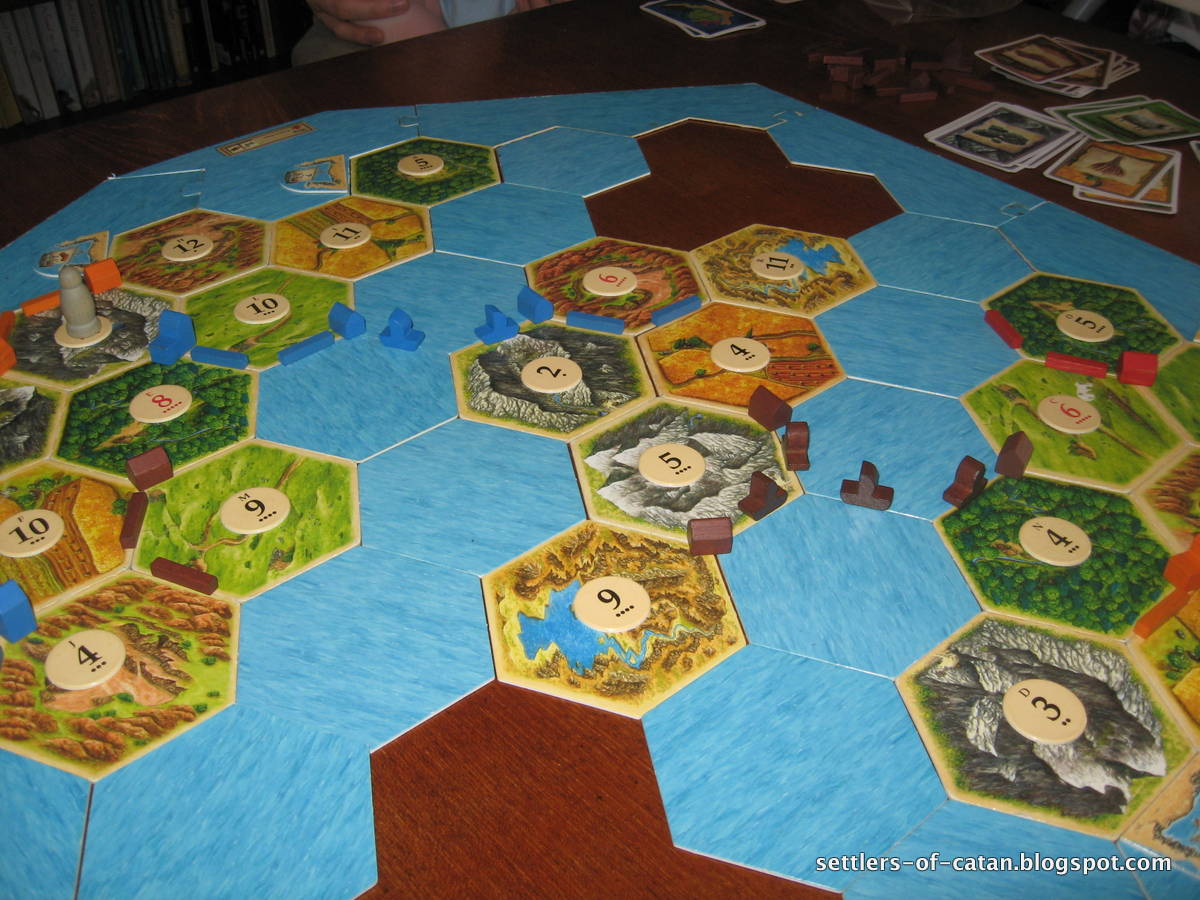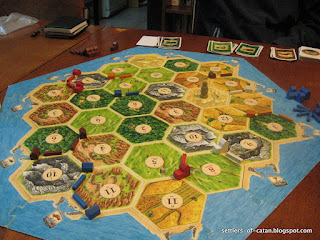Our usual default Catan game is Cities and Knights. It was quite a steep learning curve before we could relax into it, but now we can chat while playing; and do so at least once per week. Nothing spectacular has happened, so I haven't written about every game as I did at first. Indeed, I haven't written anything here for some years.
At Christmas we were given 'Explorers and Pirates', touted as the expansion to beat all other expansions.
It looked complicated - we spent probably an hour just pushing the cardboard hexes and other pieces out of their slots and sorting them into the provided bags. We started to read the instructions but got rather bogged down and decided we were too tired to try it out on Christmas Day.
It was almost six weeks later that we took it out again, determined to try the first scenario. I read aloud while the other players put the board together. We had to use fourteen ordinary hexes from our regular Settlers game, plus most of the numbers and the outside frame pieces. But there was no robber, no development cards, not even a 'longest street' card.
We pulled out the bag of pieces labelled 'Standard':
It's really very well designed, each bag having a labelled board showing exactly which pieces should be in it. In this bag we found terrain hexes (with green stars or orange moons on the back), and number tokens, which we had already put in an old film canister.
We also needed to use some extra sea frame pieces, plus the bag of 'gold' circles:
From our previously-sorted wooden pieces from 'Explorers and Pirates' the instructions directed us to use the 'harbours' and 'ships' and also the 'settlers'.
A harbour, we learned, functions a bit like a city in that it provides two victory points. But only one of each resource is gained when rolling a number adjacent to a harbour. It takes two ore and two wheat resources to upgrade a settlement to a harbour, and - importantly, but logically - it can only be built on an intersection point with sea.
The ships, as in the Seafarers expansion, cost one sheep (pasture) resource, and one wood (lumber). However they don't function quite like the Seafarers ships. There are only three of them per person, and they can move, up to four sea routes (intersections), at the end of a turn. In addition, they can transport the settlers pieces (and others, in future expansions, but only the settlers were used in this game).
Each settlers piece, like a settlement, can be bought with one each of wood, clay (brick), wheat and sheep.
Just reading the instructions, and setting out the basic board took us about forty-five minutes, although no doubt this will speed up for future games.
We each started with one settlement, one harbour and one road for each of them, much like a normal Settlers game. But we didn't place them ourselves: we followed the instructions for the beginning game, and put them where we were told to, on a board laid out exactly like the one in the instruction leaflet.
Like the 'Fog Island' scenarios in 'Seafarers', ships can 'explore' the upside down hexes, and discover either resources or more sea. For standard hexes, a number is placed and a resource of that kind added to the player's hand (as in Seafarers). But if a sea hex is discovered, the player gains two gold coins; coins can be exchanged for a resource of the player's choice, but not immediately since exploring ends the turn.
Only one hex can be 'explored' per ship per turn, and there are rules about not building roads or settlements next to sea tiles, so exploring cannot happen using anything other than a ship. When a ship is carrying a settler tile, and arrives at a suitable intersection (ie with no undiscovered hexes) the ship and settlement can be removed and replaced with a standard settlement on that spot, at no further cost.
It didn't take longer to explore, and with two separate islands there was plenty of scope for doing so. Further settlements can be built in the same way, by buying another ship and settler (the ship must be at a harbour if a settler is to be bought) or by building streets and settlements as in the normal game.
There are a few extra rules too: there is no robber, but if a seven is rolled any players with more than seven cards still lose half of them. If a number is rolled (other than seven) then any player who does not receive resources is given a gold coin instead. Players can trade with each other as normal, including for gold coins, but if they want to trade with the bank the standard is three of any resource - as if everyone has a 3:1 harbour/port. There are no trading ports in this game.
We were told to play to eight points, but were close to that after only about half an hour of playing. And since we had started according to the instructions, presumably with as even starting positions as possible, we all reached seven points in the same round. So we decided to keep playing until ten points; we usually play to two points more than the official number.
But it remained even, and when Sheila (playing white) reached ten points, Richard (red) and I (orange) had each gained nine points, and both knew that we could have won on our turns.
Our immediate response was that we liked it, and could see that it could form the basis of some interesting games. There are three main scenarios to be played, which no doubt we will try out over the next few months. But it was good to establish the basic rules before moving on to far more complicated scenarios.
At Christmas we were given 'Explorers and Pirates', touted as the expansion to beat all other expansions.
It looked complicated - we spent probably an hour just pushing the cardboard hexes and other pieces out of their slots and sorting them into the provided bags. We started to read the instructions but got rather bogged down and decided we were too tired to try it out on Christmas Day.
It was almost six weeks later that we took it out again, determined to try the first scenario. I read aloud while the other players put the board together. We had to use fourteen ordinary hexes from our regular Settlers game, plus most of the numbers and the outside frame pieces. But there was no robber, no development cards, not even a 'longest street' card.
We pulled out the bag of pieces labelled 'Standard':
It's really very well designed, each bag having a labelled board showing exactly which pieces should be in it. In this bag we found terrain hexes (with green stars or orange moons on the back), and number tokens, which we had already put in an old film canister.
We also needed to use some extra sea frame pieces, plus the bag of 'gold' circles:
From our previously-sorted wooden pieces from 'Explorers and Pirates' the instructions directed us to use the 'harbours' and 'ships' and also the 'settlers'.
A harbour, we learned, functions a bit like a city in that it provides two victory points. But only one of each resource is gained when rolling a number adjacent to a harbour. It takes two ore and two wheat resources to upgrade a settlement to a harbour, and - importantly, but logically - it can only be built on an intersection point with sea.
The ships, as in the Seafarers expansion, cost one sheep (pasture) resource, and one wood (lumber). However they don't function quite like the Seafarers ships. There are only three of them per person, and they can move, up to four sea routes (intersections), at the end of a turn. In addition, they can transport the settlers pieces (and others, in future expansions, but only the settlers were used in this game).
Each settlers piece, like a settlement, can be bought with one each of wood, clay (brick), wheat and sheep.
Just reading the instructions, and setting out the basic board took us about forty-five minutes, although no doubt this will speed up for future games.
We each started with one settlement, one harbour and one road for each of them, much like a normal Settlers game. But we didn't place them ourselves: we followed the instructions for the beginning game, and put them where we were told to, on a board laid out exactly like the one in the instruction leaflet.
Like the 'Fog Island' scenarios in 'Seafarers', ships can 'explore' the upside down hexes, and discover either resources or more sea. For standard hexes, a number is placed and a resource of that kind added to the player's hand (as in Seafarers). But if a sea hex is discovered, the player gains two gold coins; coins can be exchanged for a resource of the player's choice, but not immediately since exploring ends the turn.
Only one hex can be 'explored' per ship per turn, and there are rules about not building roads or settlements next to sea tiles, so exploring cannot happen using anything other than a ship. When a ship is carrying a settler tile, and arrives at a suitable intersection (ie with no undiscovered hexes) the ship and settlement can be removed and replaced with a standard settlement on that spot, at no further cost.
It didn't take longer to explore, and with two separate islands there was plenty of scope for doing so. Further settlements can be built in the same way, by buying another ship and settler (the ship must be at a harbour if a settler is to be bought) or by building streets and settlements as in the normal game.
There are a few extra rules too: there is no robber, but if a seven is rolled any players with more than seven cards still lose half of them. If a number is rolled (other than seven) then any player who does not receive resources is given a gold coin instead. Players can trade with each other as normal, including for gold coins, but if they want to trade with the bank the standard is three of any resource - as if everyone has a 3:1 harbour/port. There are no trading ports in this game.
We were told to play to eight points, but were close to that after only about half an hour of playing. And since we had started according to the instructions, presumably with as even starting positions as possible, we all reached seven points in the same round. So we decided to keep playing until ten points; we usually play to two points more than the official number.
But it remained even, and when Sheila (playing white) reached ten points, Richard (red) and I (orange) had each gained nine points, and both knew that we could have won on our turns.
Our immediate response was that we liked it, and could see that it could form the basis of some interesting games. There are three main scenarios to be played, which no doubt we will try out over the next few months. But it was good to establish the basic rules before moving on to far more complicated scenarios.

























































